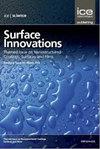Fluid droplet spreading and adhesion studied by a microbalance: a review
IF 2.7
4区 材料科学
Q3 CHEMISTRY, PHYSICAL
引用次数: 0
Abstract
A contact angle observed for a liquid-solid system is not necessarily a unique value and a few contact angles need to be carefully considered in relation to liquid spreading, adhesion and phase separation. Understanding of the significance of different contact angles has improved in the last few years through direct measurements of interactive forces between droplets/bubbles and solids together with the simultaneous visualization of the changes in their shapes. A microelectronic balance system is employed to measure the force of spreading after either liquid droplet or gas bubble attachment to a substrate surface, and the droplet/bubble-substrate adhesion forces after droplet/bubble compression, retraction, and detachment. Equipped with a camera in flank and data acquisition software, the instrument measures directly the forces, monitors droplet/bubble-surface separation with respect to distances over which the droplet/bubble stretches and collects optical images simultaneously. The images are used to analyze capillary pressure and surface tension forces based on the measured droplet/bubble dimensions, shapes of surfaces and values of contact angles. These measurements allow researchers to correlate the advancing, receding and most-stable contact angles with liquid-solid interactive forces and analyze their scientific meaning. This review summarizes the very recent literature reports on measurements and interpretation of liquid droplet/gas bubble interactive forces and associated contact angles.微天平研究液滴扩散和粘附的研究进展
对于液-固系统观察到的接触角不一定是唯一的值,并且需要仔细考虑与液体铺展、粘附和相分离有关的几个接触角。在过去几年中,通过直接测量液滴/气泡和固体之间的相互作用力,以及同时可视化其形状的变化,对不同接触角的重要性的理解有所提高。采用微电子平衡系统来测量液滴或气泡附着到基板表面后的扩散力,以及液滴/气泡压缩、收缩和分离后的液滴/泡基板附着力。该仪器配备了侧面摄像头和数据采集软件,可以直接测量力,监测液滴/气泡表面的分离情况,以及液滴/泡沫拉伸的距离,并同时收集光学图像。这些图像用于基于测量的液滴/气泡尺寸、表面形状和接触角值来分析毛细管压力和表面张力。这些测量使研究人员能够将前进、后退和最稳定的接触角与液固相互作用力联系起来,并分析其科学意义。这篇综述总结了最近关于液滴/气泡相互作用力和相关接触角的测量和解释的文献报告。
本文章由计算机程序翻译,如有差异,请以英文原文为准。
求助全文
约1分钟内获得全文
求助全文
来源期刊

Surface Innovations
CHEMISTRY, PHYSICALMATERIALS SCIENCE, COAT-MATERIALS SCIENCE, COATINGS & FILMS
CiteScore
5.80
自引率
22.90%
发文量
66
期刊介绍:
The material innovations on surfaces, combined with understanding and manipulation of physics and chemistry of functional surfaces and coatings, have exploded in the past decade at an incredibly rapid pace.
Superhydrophobicity, superhydrophlicity, self-cleaning, self-healing, anti-fouling, anti-bacterial, etc., have become important fundamental topics of surface science research community driven by curiosity of physics, chemistry, and biology of interaction phenomenon at surfaces and their enormous potential in practical applications. Materials having controlled-functionality surfaces and coatings are important to the manufacturing of new products for environmental control, liquid manipulation, nanotechnological advances, biomedical engineering, pharmacy, biotechnology, and many others, and are part of the most promising technological innovations of the twenty-first century.
 求助内容:
求助内容: 应助结果提醒方式:
应助结果提醒方式:


